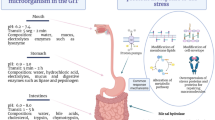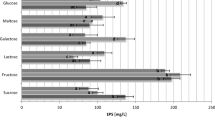Abstract
The acid tolerance is particularly important for bifidobacteria to function as probiotics because they usually encounter acidic environments in food products and gastrointestinal tract passage. In this study, two acid-resistant derivatives Bifidobacterium longum JDY1017dpH and Bifidobacterium breve BB8dpH, which displayed a stable acid-resistant phenotype, were generated. The relationship between acid tolerance and cell membrane was investigated by comparing the two acid-resistant derivatives and their parental strains grown in medium with and without Tween 80. The fold increase in acid tolerance of the two acid-resistant derivatives relative to their parental strains was much higher when cells were grown in medium with Tween 80 (104 ~ 105-fold) than without Tween 80 (181- and 245-fold). Moreover, when cells were grown in medium with Tween 80, the two acid-resistant derivatives exhibited more C18:1 and cycC19:0, higher mean fatty acid chain length, lower membrane fluidity, and higher expression of cfa gene encoding cyclopropane fatty acid synthase than their parental strains. No significant differences in cell membrane were observed between the two acid-resistant derivatives and their parental strains when cells were grown in medium without Tween 80. The present study revealed that, when cells were grown in medium with Tween 80, the significant fold increase in acid tolerance of the two acid-resistant derivatives was mainly ascribed to the pronounced changes in cell membrane compared with their parental strains. Results presented here could provide a basis for developing new strategies of cell membrane modification to enhance acid tolerance in bifidobacteria.





Similar content being viewed by others
References
Álvarez-Ordóñez A, Fernández A, López M, Bernardo A (2009) Relationship between membrane fatty acid composition and heat resistance of acid and cold stressed Salmonella senftenberg CECT 4384. Food Microbiol 26(3):347–353
Aricha B, Fishov I, Cohen Z, Sikron N, Pesakhov S, Khozin-Goldberg I, Dagan R, Porat N (2004) Differences in membrane fluidity and fatty acid composition between phenotypic variants of Streptococcus pneumoniae. J Bacteriol 186(14):4638–4644
Aureli P, Capurso L, Castellazzi AM, Clerici M, Giovannini M, Morelli L, Poli A, Pregliasco F, Salvini F, Zuccotti GV (2011) Probiotics and health: an evidence-based review. Pharmacol Res 63(5):366–376
Ausubel F, Brent R, Kingston R, Moore D, Seidman J, Smith J (2002) Short protocols in molecular biology, 5th edn. Wiley, New York
Berger B, Moine D, Mansourian R, Arigoni F (2010) HspR mutations are naturally selected in Bifidobacterium longum when successive heat shock treatments are applied. J Bacteriol 192(1):256–263
Broadbent JR, Larsen RL, Deibel V, Steele JL (2010) Physiological and transcriptional response of Lactobacillus casei ATCC 334 to acid stress. J Bacteriol 192(9):2445–2458
Broadbent JR, Oberg TS, Hughes JE, Ward RE, Brighton C, Welker DL, Steele JL (2014) Influence of polysorbate 80 and cyclopropane fatty acid synthase activity on lactic acid production by Lactobacillus casei ATCC 334 at low pH. J Ind Microbiol Biotechnol 41(3):545–553
Brown JL, Ross T, McMeekin TA, Nichols PD (1997) Acid habituation of Escherichia coli and the potential role of cyclopropane fatty acids in low pH tolerance. Int J Food Microbiol 37(2–3):163–173
Cao-Hoang L, Marechal P-A, Mai Lê-Thanh M, Gervais P, Waché Y (2008) Fluorescent probes to evaluate the physiological state and activity of microbial biocatalysts: a guide for prokaryotic and eukaryotic investigation. Biotechnol J 3(7):890–903
Chang YY, Cronan JE (1999) Membrane cyclopropane fatty acid content is a major factor in acid resistance of Escherichia coli. Mol Microbiol 33(2):249–259
Chu-Ky S, Tourdot-Marechal R, Marechal PA, Guzzo J (2005) Combined cold, acid, ethanol shocks in Oenococcus oeni: effects on membrane fluidity and cell viability. Biochim Biophys Acta 1717(2):118–124
Collado MC, Sanz Y (2007) Induction of acid resistance in Bifidobacterium: a mechanism for improving desirable traits of potentially probiotic strains. J Appl Microbiol 103(4):1147–1157
Corcoran BM, Stanton C, Fitzgerald G, Ross RP (2008) Life under stress: the probiotic stress response and how it may be manipulated. Curr Pharm Des 14(14):1382–1399
Cotter PD, Hill C (2003) Surviving the acid test: responses of gram-positive bacteria to low pH. Microbiol Mol Biol Rev 67(3):429–453
Da Silveira MG, Golovina EA, Hoekstra FA, Rombouts FM, Abee T (2003) Membrane fluidity adjustments in ethanol-stressed Oenococcus oeni cells. Appl Environ Microbiol 69(10):5826–5832
FAO/WHO (2001) Health and nutritional properties of probiotics in food including powder milk with live lactic acid bacteria. Report of a joint FAO/WHO expert consultation on evaluation of health and nutritional properties of probiotics in food including powder milk with live lactic acid bacteria. Córdoba, Argentina. Available at: ftp://ftp.fao.org/docrep/fao/009/a0512e/a0512e00.pdf. Accessed 19 Nov 2004
Fozo EM, Quivey RG Jr (2004) The fabM gene product of Streptococcus mutans is responsible for the synthesis of monounsaturated fatty acids and is necessary for survival at low pH. J Bacteriol 186(13):4152–4158
Grogan DW, Cronan JE (1997) Cyclopropane ring formation in membrane lipids of bacteria. Microbiol Mol Biol Rev 61(4):429–441
Gueimonde M, Tölkkö S, Korpimäki T, Salminen S (2004) New real-time quantitative PCR procedure for quantification of bifidobacteria in human fecal samples. Appl Environ Microbiol 70(7):4165–4169
Guerzoni ME, Lanciotti R, Cocconcelli PS (2001) Alteration in cellular fatty acid composition as a response to salt, acid, oxidative and thermal stresses in Lactobacillus helveticus. Microbiology 147(8):2255–2264
Harmsen HJM, Wildeboer–Veloo ACM, Raangs GC, Wagendorp AA, Klijn N, Bindels JG, Welling GW (2000) Analysis of intestinal flora development in breast-fed and formula-fed infants by using molecular identification and detection methods. J Pediatr Gastroenterol Nutr 30(1):61–67
Jin J, Zhang B, Guo H, Cui J, Jiang L, Song S, Sun M, Ren F (2012) Mechanism analysis of acid tolerance response of Bifidobacterium longum subsp. longum BBMN 68 by gene expression profile using RNA-sequencing. PLoS One 7:e50777. doi:10.1371/journal.pone.0050777
Johnsson T, Nikkila P, Toivonen L, Rosenqvist H, Laakso S (1995) Cellular fatty acid profiles of Lactobacillus and Lactococcus strains in relation to the oleic acid content of the cultivation medium. Appl Environ Microbiol 61(12):4497–4499
Kanjee U, Houry WA (2013) Mechanisms of acid resistance in Escherichia coli. Annu Rev Microbiol 67:65–81
Khelaifia S, Fardeau ML, Pradel N, Aussignargues C, Garel M, Tamburini C, Cayol JL, Gaudron S, Gaill F, Ollivier B (2011) Desulfovibrio piezophilus sp. nov., a piezophilic, sulfate-reducing bacterium isolated from wood falls in the Mediterranean Sea. Int J Syst Evol Microbiol 61(11):2706–2711
Kim BH, Kim S, Kim HG, Lee J, Lee IS, Park YK (2005) The formation of cyclopropane fatty acids in Salmonella enterica serovar typhimurium. Microbiology 151(1):209–218
Langendijk PS, Schut F, Jansen GJ, Raangs GC, Kamphuis GR, Wilkinson MH, Welling GW (1995) Quantitative fluorescence in situ hybridization of Bifidobacterium spp. with genus-specific 16S rRNA-targeted probes and its application in fecal samples. Appl Environ Microbiol 61(8):3069–3075
Lay C, Rigottier-Gois L, Holmstrøm K, Rajilic M, Vaughan EE, De Vos WM, Collins MD, Thiel R, Namsolleck P, Blaut M, Doré J (2005) Colonic microbiota signatures across five northern European countries. Appl Environ Microbiol 71(7):4153–4155
Livak KJ, Schmittgen TD (2001) Analysis of relative gene expression data using real-time quantitative PCR and the 2-∆∆Ct method. Methods 25(4):402–408
Marteau P, Rambaud JC (1993) Potential of using lactic acid bacteria for therapy and immunomodulation in man. FEMS Microbiol Rev 12:207–220
Matsumoto M, Ohishi H, Benno Y (2004) H+-ATPase activity in Bifidobacterium with special reference to acid tolerance. Int J Food Microbiol 93(1):109–113
Maus JE, Ingham SC (2003) Employment of stressful conditions during culture production to enhance subsequent cold- and acid-tolerance of bifidobacteria. J Appl Microbiol 95(1):146–154
Mykytczuk NCS, Trevors JT, Leduc LG, Ferroni GD (2007) Fluorescence polarization in studies of bacterial cytoplasmic membrane fluidity under environmental stress. Prog Biophys Mol Biol 95(1–3):60–82
Oberg TS, Ward RE, Steele JL, Broadbent JR (2013) Genetic and physiological responses of Bifidobacterium animalis subsp. lactis to hydrogen peroxide stress. J Bacteriol 195(16):3743–3751
Parvez S, Malik KA, Ah Kang S, Kim HY (2006) Probiotics and their fermented food products are beneficial for health. J Appl Microbiol 100(6):1171–1185
Revilla-Guarinos A, Alcántara C, Rozès N, Voigt B, Zúñiga M (2014) Characterization of the response to low pH of Lactobacillus casei ΔRR12, a mutant strain with low D-alanylation activity and sensitivity to low pH. J Appl Microbiol 116(5):1250–1261
Ruiz L, Ruas-Madiedo P, Gueimonde M, de los Reyes-Gavilán CG, Margolles A, Sánchez B (2011) How do bifidobacteria counteract environmental challenges? Mechanisms involved and physiological consequences. Genes Nutr 6(3):307–318
Russell DA, Ross RP, Fitzgerald GF, Stanton C (2011) Metabolic activities and probiotic potential of bifidobacteria. Int J Food Microbiol 149(1):88–105
Russell NJ (1984) Mechanisms of thermal adaptation in bacteria: blueprints for survival. Trends Biochem Sci 9(3):108–112
Sánchez B, Champomier-Vergès MC, Collado MC, Anglade P, Baraige F, Sanz Y, de los Reyes-Gavilán CG, Margolles A, Zagorec M (2007) Low-pH adaptation and the acid tolerance response of Bifidobacterium longum biotype longum. Appl Environ Microbiolol 73(20):6450–6459
Sánchez B, de los Reyes-Gavilán CG, Margolles A (2006) The F1F0-ATPase of Bifidobacterium animalis is involved in bile tolerance. Environ Microbiol 8(10):1825–1833
Saarela M, Rantala M, Hallamaa K, Nohynek L, Virkajärvi I, Mättö J (2004) Stationary-phase acid and heat treatments for improvement of the viability of probiotic lactobacilli and bifidobacteria. J Appl Microbiol 96(6):1205–1214
Shinitzky M (1984) Membrane fluidity and cellular functions. In: Shinitzky M (ed) Physiology of membrane fluidity. CRC Press, Boca Raton, Fla, pp 1–52
To TMH, Grandvalet C, Tourdot-Maréchal R (2011) Cyclopropanation of membrane unsaturated fatty acids is not essential to the acid stress response of Lactococcus lactis subsp. cremoris. Appl Environ Microbiol 77(10):3327–3334
Vaugien L, Prevots F, Roques C (2002) Bifidobacteria identification based on 16S rRNA and pyruvate kinase partial gene sequence analysis. Anaerobe 8(6):341–344
Ventura M, Canchaya C, van Sinderen D, Fitzgerald GF, Zink R (2004a) Bifidobacterium lactis DSM 10140: identification of the atp (atpBEFHAGDC) operon and analysis of its genetic structure, characteristics, and phylogeny. Appl Environ Microbiolol 70(5):3110–3121
Ventura M, van Sinderen D, Fitzgerald GF, Zink R (2004b) Insights into the taxonomy, genetics and physiology of bifidobacteria. Antonine Van Leeuwenhoek 86:205–223
Vitali B, Turroni S, Serina S, Sosio M, Vannini L, Candela M, Guerzoni ME, Brigidi P (2008) Molecular and phenotypic traits of in-vitro-selected mutants of Bifidobacterium resistant to rifaximin. Int J Antimicrob Agents 31(6):555–560
Waddington L, Cyr T, Hefford M, Hansen LT, Kalmokoff M (2010) Understanding the acid tolerance response of bifidobacteria. J Appl Microbiol 108(4):1408–1420
Wang Y, Corrieu G, Béal C (2005) Fermentation pH and temperature influence the cryotolerance of Lactobacillus acidophilus RD758. J Dairy Sci 88(1):21–29
Wu C, Huang J, Zhou R (2014) Progress in engineering acid stress resistance of lactic acid bacteria. Appl Microbiol Biotechnol 98(3):1055–1063
Wu C, Zhang J, Wang M, Du G, Chen J (2012) Lactobacillus casei combats acid stress by maintaining cell membrane functionality. J Ind Microbiol Biotechnol 39(7):1031–1039
Yang Y, Kadim MI, Khoo WJ, Zheng Q, Setyawati MI, Shin Y-J, Lee S-C, Yuk H-G (2014a) Membrane lipid composition and stress/virulence related gene expression of Salmonella enteritidis cells adapted to lactic acid and trisodium phosphate and their resistance to lethal heat and acid stress. Int J Food Microbiol 191:24–31
Yang Y, Khoo WJ, Zheng Q, Chung H, Yuk H-G (2014b) Growth temperature alters Salmonella enteritidis heat/acid resistance, membrane lipid composition and stress/virulence related gene expression. Int J Food Microbiol 172:102–109
Yuk H-G, Marshall DL (2004) Adaptation of Escherichia coli O157: H7 to pH alters membrane lipid composition, verotoxin secretion, and resistance to simulated gastric fluid acid. Appl Environ Microbiol 70(6):3500–3505
Acknowledgments
This work was supported by the National Basic Research Program of China (973 Program) (No. 2012CB720802) and the National High Technology Research and Development Program of China (863 Program) (No. 2011AA100901).
Author information
Authors and Affiliations
Corresponding author
Rights and permissions
About this article
Cite this article
Yang, X., Hang, X., Zhang, M. et al. Relationship between acid tolerance and cell membrane in Bifidobacterium, revealed by comparative analysis of acid-resistant derivatives and their parental strains grown in medium with and without Tween 80. Appl Microbiol Biotechnol 99, 5227–5236 (2015). https://doi.org/10.1007/s00253-015-6447-y
Received:
Revised:
Accepted:
Published:
Issue Date:
DOI: https://doi.org/10.1007/s00253-015-6447-y




